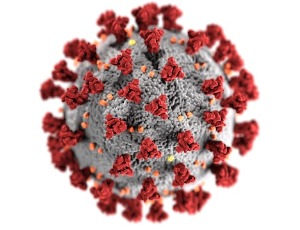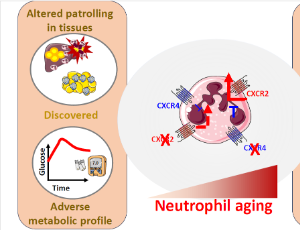Loading
Journal of Cellular Immunology
ISSN: 2689-2812

2023
Volume 5, Issue 5, p141-173
Articles published in this issue are Open Access and licensed under Creative Commons Attribution License (CC BY NC) where the readers can reuse, download, distribute the article in whole or part by mentioning proper credits to the authors.
Examining the Relationship between SARS-CoV-2 Infection and Type 1 Diabetes: A Reanalysis of Recent Findings
Yongxin Zhang, Ying Wang
Type 1 diabetes (T1D), an autoimmune disease mediated by T cells, has long been associated with various viral infections [1-4]. Among these infections, enterovirus infection [5-7] was more consistently reported to contribute to the development of T1D
J Cell Immunol, 2023, Volume 5, Issue 5, p141-142 | DOI: 10.33696/immunology.5.179
Expansion of Proteome-wide Coxiella burnetii Comparative T-cell Epitope Prediction to Include Small Ruminant Hosts
Paige C. Grossman, David A. Schneider, Robert Kirkpatrick, Stephen N. White, Lindsay M.W. Piel
Coxiella burnetii is the causative agent of Q fever, a human disease that can be acquired from livestock. Diseases caused by this organism have caused great losses in livestock and human health. No vaccine is approved for use in the United States, and formalininactivated whole-cell vaccines pose a significant manufacturing risk for biocontainment.
J Cell Immunol, 2023, Volume 5, Issue 5, p143-161 | DOI: 10.33696/immunology.5.180
- Abstract |
- Full Text |
- Cite |
- Supplementary File
Role of Regulatory T cells in Prognosis, Diagnosis, and Treatment of Kidney Transplant Recipients
Katyayani Bejugama, Swarnalatha Guditi
The major issue in kidney transplantation remains the suppression of allograft rejection. Immunosuppressant decrease both donor-specific responsiveness and the risk of rejection in the months after transplantation and are maintained. The current immunosuppressant medications, although potent against short-time graft complications including acute renal rejection but are still less effective to ensure long-term graft survival.
J Cell Immunol, 2023, Volume 5, Issue 5, p162-167 | DOI: 10.33696/immunology.5.181
The High Fat Diet Impacts the Plasticity between Fresh and Aged Neutrophils
Andrea Baragetti, Giuseppe Danilo Norata
Metabolic alterations induced by unhealthy lifestyles, including obesity and insulin resistance are often associated with increased innate immune response and chronic inflammation. Cholesterol has been identified as a key metabolite driving the activation of the inflammasome and the “epigenetic memory” in long-term living hematopoietic stem cells.
J Cell Immunol, 2023, Volume 5, Issue 5, p168-173 | DOI: 10.33696/immunology.5.182
Recommended Articles
A Bioinformatics Protocol for Rational Design of Peptide Vaccines and the COVID-19 Rampage
The currently ongoing coronavirus pandemic, the SARSCOV- 2, interchangeably referred to as the COVID-19 infection, has in a short span of time altered the ways and means of almost all of mankind. So strong has been its effect that all human activity ceased in one way or another for a considerable time, led to significant loss of life and economic drain of.
Safety of Using Rituximab Therapy During COVID-19 Pandemic
Rituximab is a chimeric (20% rodent and 80% human) monoclonal antibody that binds to the CD20 antigen present on the cell surface and leads to depletion of mature B-cells [1,2]. It is the first approved monoclonal antibody to be used in the therapy of indolent B-cell non- Hodgkin’s lymphoma and chronic lymphocytic leukemia
In silico Analysis for the Repurposing of Broad-spectrum Antiviral Drugs against Multiple Targets from SARS-CoV-2: A Molecular Docking and ADMET Approach
SARS-CoV-2 belongs to the genus Beta of the Coronaviridae family of enveloped single-stranded, positive-sense ribonucleic acid (RNA) with a genome length of 30,000bp. The virion is composed of various non-structural (RNA dependent RNA polymerase also known as RdRp) and structural proteins such as Spike (S), Nucleocapsid (N), Matrix (M), and Envelope (E) proteins.
Beta-Sitosterol: As Immunostimulant, Antioxidant and Inhibitor of SARS-CoV-2 Spike Glycoprotein
This article is an extension to our recently published article in Asian Journal of Pharmaceutical and Clinical Research, entitled “Β-Sitosterol: Isolation from Muntingia Calabura Linn. Bark Extract, Structural Elucidation, and Molecular Docking Studies as Potential Inhibitor of SARSCoV-2 Mpro (COVID-19)”[1].
Rapid Inactivation of SARS-CoV-2 by Coupling Tungsten Trioxide (WO3) Photocatalyst with Copper Nanoclusters
At the end of 2019, a novel severe respiratory disease (coronavirus disease 2019, COVID-19) spread to Wuhan, China, it became pandemic in few months, with more than 41 million people infected worldwide as of October 2020. COVID-19 is caused by a novel virus called severe acute respiratory syndrome (SARS) CoV-2 to distinguish it from SARS-CoV that emerged in Guangdong province in China in 2003 and caused the severe clinical condition known as SARS. Like SARS-CoV, SARS- CoV-2 causes a severe inter
Quantifying Respiratory Airborne Particle Dispersion Control Through Improvised Reusable Masks: The Physics of Non-Pharmaceutical Interventions for Reducing SARS-CoV-2 (COVID-19) Airborne Transmission
In light of the current pandemic from rapid transmission of the severe acute respiratory syndrome coronavirus 2 (SARS-CoV-2 or COVID-19) and significant morbidity, there has been inconsistent medical guidance given to the public regarding the wearing of non-medical improvised fabric masks or face coverings to reduce the transmission of COVID-19.
In Silico Proteome Analysis of Severe Acute Respiratory Syndrome Coronavirus 2 (SARS-CoV-2)
Severe acute respiratory syndrome coronavirus 2 (SARSCoV- 2) is a positive-sense, single-stranded RNA with genome size 26.2, and 31.7 kb coronavirus, covered by an enveloped structure, which is a major source of disaster in the 21st century. A typical CoV contains at least six ORFs in its genome. SARS-CoV-2 is the seventh coronavirus that is known to cause human disease.
COVID-19 Disease and SARS-CoV-2 Vaccination in Patients with Cancer
Since the declaration of COVID-19 as a pandemic in March 2020 [1], there have been more than 100 million reported cases of COVID-19 worldwide and more than 2.1 million deaths [2].
Autism – A Potential Autoimmune Disease Neurodegeneration-Induced Autoantibodies against Neural Proteins
Autism spectrum disorder (ASD) is a neurodevelopmental disorder characterized by difficulty in communication and repetitive behaviors [1]. ASD definition includes: atypical autism, high-functioning autism, and Asperger’s disorder. Individuals with ASD may have extraordinarily high IQ, normal intellectual abilities, or intellectual disability (ID), known as ASD with ID.
ProLung™-budesonide Inhibits SARS-CoV-2 Replication and Reduces Lung Inflammation
Inhaled budesonide benefits patients with COVID-19. ProLung™-budesonide enables the sustained, low dose administration of budesonide within a delivery vehicle similar to lung surfactant.
S1P Generation by Sphingosine Kinase-2 in Recruited Macrophages Resolves Lung Inflammation by Blocking STING Signaling in Alveolar Macrophages
Acute respiratory distress syndrome (ARDS) is the major cause of mortality among hospitalized acute lung injury (ALI) patients. Lung macrophages play an important role in maintaining the tissue-fluid homeostasis following injury. We recently showed that circulating monocytes recruited into the alveolar space suppressed the stimulator of type 1 interferon genes (STING) signaling in alveolar macrophages through sphingosine-1-phosphate (S1P).
Photodynamic Therapy for the Prevention of SARS-CoV-2 Infection in Dental Office: Could be Possible?
In January 2020, the World Health Organization (WHO) identified a novel coronavirus SARS-CoV-2 in the Wuhan province of China, which has since caused a worldwide pandemic, with more than 21.2 million confirmed cases and over 760,200 confirmed deaths as of 14 August 2020. SARS-CoV-2 is a single-stranded RNA virus classified in
News About the Extracellular Vesicles from Mesenchymal Stem Cells: Functions, Therapy and Protection from COVID-19
The present Commentary is a critical follow-up of a previous review about “Extracellular vesicles, news about their role in immune cells: physiology, pathology and diseases”, appeared in Clinical and Experimental Immunology last June 2019 [1].
Isolated Kidney Infarct and Lupus Anticoagulant Positivity in a Young Patient with Mild SARS-CoV-2 Infection
The incidence of thromboembolic events in COVID-19 is reportedly higher in intensive care unit (ICU) patients (29.4%) as compared to non-ICU patients (11.5%), while data on thromboembolic events in non-hospitalized, self-limiting COVID-19 is unavailable. Renal infarction with COVID-19 has only been reported in three patients who had severe infection, multiple comorbidities, and/or immuno-compromised state post kidney transplantation. Since the onset of the SARS-CoV-2 pandemic, guidelines for the prophylaxis and treatment of COVID- 19-related hypercoagulability have only been focused on hospitalized patients. Concurrently, risk factors and management guidelines for thromboembolic events in mild COVID-19 have remained unidentified. In this report, we describe a case of a 38-year-old male–with no medical history pertinent to hypercoagulability–who developed an isolated renal infarction one week after being diagnosed with mild COVID-19.
Autoantibodies in Overlapping Systemic Sclerosis and Primary Biliary Cirrhosis Autoimmune Diseases
Anticentromere antibodies (ACA) are considered an important diagnostic marker of scleroderma or systemic sclerosis (SSc), being CENP-B the major centromere auto-antigen recognized by sera from SSc patients. However, ACA can also be detected in patients with other connective tissue diseases.
Efficacy of a Virtual Fracture Clinic Model Created During Covid-19 Pandemic
The COVID-19 pandemic has caused delivery of orthopaedic services to require extra consideration and substantial revision. Alternative ways to manage patients with urgent injuries have been instigated to minimize patient’s exposure to the disease, spread within the hospital system and reduce the overall impact on stretched resources.
Cancer Stem Cells, Together with Mesenchymal Stem Cells and Other Cooperative Cells, Govern the Initiation and Development of Cancer
Until the end of last century, the origin and development of cancers were mostly attributed to the proliferation of their active cells, operative in collaboration with non-cancer cells of the patients. In particular, an important role was attributed to cells now recognized as mesenchymal stem cells (MSCs), first considered a few decades ago. Initially, however, the role attributed to these cells was only limited.
Duration of SARS-CoV-2 Infectivity
The ongoing SARS-CoV-2 pandemic led to a high number of deaths worldwide as well as an overload of healthcare systems and an economic collapse. One of the reasons can be attributed to the lack of knowledge about the duration of infectivity at the beginning of the pandemic, resulting in hospital isolation of patients and
Structural Consequences of Variation in SARS-CoV-2 B.1.1.7
New globally circulating SARS-CoV-2 strains are causing concern about evolution of virus transmissibility, fitness and immune evasion mechanisms. A variant emerging from the United Kingdom called SARS-CoV-2 VUI 202012/01, or B.1.1.7, is thought to exhibit increased transmissibility that results from replication 4-10 times faster than the original Wuhan virus (Wuhan-Hu-1).
Increased Binding Affinity of Furin to D614G Mutant S-glycoprotein May Augment Infectivity of the Predominating SARS-CoV-2 Variant
The coronavirus disease (COVID)-19 pandemic has profoundly devastated human health and wellbeing all over the world, along with colossal setback to global economy in terms of soaring new infections, hospitalizations, ICU admissions, work losses, closures of businesses and institutions, bankruptcies, and precautionary measures
About Scientific Archives
Scientific Archives is a global publisher initiated with the mission of ensuring equal opportunity for accessing science to research community all over the world. Spreading research findings with great relevance to all channels without any barrier is our goal. We want to overcome the challenges of Open Access with ensured quality and transparency.
